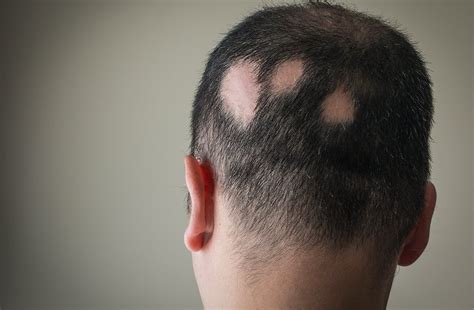Bald head patches, medically known as alopecia areata, is a common autoimmune disorder that causes hair loss in round or oval patches on the scalp. While it can affect people of all ages, it is most commonly seen in young adults.

Symptoms
The main symptom of bald head patches is the sudden appearance of round or oval patches of hair loss. The patches can vary in size from small, coin-sized areas to large, palm-sized areas. The hair loss is usually non-scarring, meaning that the hair follicles are not permanently damaged and hair can grow back.
In some cases, bald head patches can also be accompanied by other symptoms, such as:
- Tingling or burning sensation on the scalp
- Itching
- Redness
- Scaling
Causes
The exact cause of bald head patches is unknown, but it is thought to be an autoimmune disorder. This means that the body’s immune system mistakenly attacks the hair follicles, causing them to stop producing hair.
Bald head patches can be triggered by a variety of factors, including:
- Stress
- Illness
- Medications
- Pregnancy
- Childbirth
- Thyroid problems
- Diabetes
- Certain autoimmune diseases
Types
There are several different types of bald head patches, including:
- Alopecia areata: This is the most common type of bald head patches. It causes round or oval patches of hair loss on the scalp.
- Alopecia totalis: This type of hair loss causes complete loss of all hair on the scalp.
- Alopecia universalis: This type of hair loss causes complete loss of all hair on the scalp, eyebrows, and eyelashes.
Diagnosis
Bald head patches can usually be diagnosed by a physical examination of the scalp. Your doctor may also ask you about your medical history and perform a blood test to rule out any underlying medical conditions.
Treatment
There is no cure for bald head patches, but there are a number of treatments that can help to slow or stop the hair loss and promote hair growth. These treatments include:
- Topical medications, such as minoxidil and corticosteroids
- Injections of corticosteroids into the scalp
- Laser therapy
- Light therapy
- Oral medications, such as finasteride and dutasteride
Prevention
There is no sure way to prevent bald head patches, but there are a few things you can do to reduce your risk of developing the condition, such as:
- Managing stress
- Getting enough sleep
- Eating a healthy diet
- Avoiding smoking and excessive alcohol consumption
- Seeing your doctor regularly for checkups
Common Mistakes to Avoid
There are a number of common mistakes that people make when trying to treat bald head patches. These mistakes can include:
- Using harsh shampoos and conditioners: Harsh shampoos and conditioners can irritate the scalp and make hair loss worse.
- Picking or scratching the scalp: Picking or scratching the scalp can damage the hair follicles and make hair loss permanent.
- Using hair extensions or weaves: Hair extensions and weaves can put tension on the hair follicles and lead to hair loss.
- Using chemical hair treatments: Chemical hair treatments, such as perms and dyes, can damage the hair and make it more likely to fall out.
FAQs
1. What is the difference between bald head patches and male pattern baldness?
Bald head patches are caused by an autoimmune disorder, while male pattern baldness is a genetic condition. Male pattern baldness typically causes a gradual thinning of hair on the top and front of the scalp, while bald head patches can cause sudden hair loss in round or oval patches.
2. Can bald head patches be cured?
There is no cure for bald head patches, but there are a number of treatments that can help to slow or stop the hair loss and promote hair growth.
3. What is the best treatment for bald head patches?
The best treatment for bald head patches will vary depending on the individual. Some of the most common treatments include topical medications, injections of corticosteroids into the scalp, laser therapy, light therapy, and oral medications.
4. Can bald head patches be prevented?
There is no sure way to prevent bald head patches, but there are a few things you can do to reduce your risk of developing the condition, such as managing stress, getting enough sleep, eating a healthy diet, avoiding smoking and excessive alcohol consumption, and seeing your doctor regularly for checkups.
5. What are the side effects of bald head patches treatments?
The side effects of bald head patches treatments can vary depending on the treatment. Some of the most common side effects include scalp irritation, redness, and swelling.
6. How long does it take for bald head patches to grow back?
The time it takes for bald head patches to grow back varies depending on the individual and the severity of the hair loss. In some cases, hair can start to grow back within a few months, while in other cases it may take a year or more.
7. What can I do to help my bald head patches grow back faster?
There are a few things you can do to help your bald head patches grow back faster, such as using topical medications, injections of corticosteroids into the scalp, laser therapy, light therapy, and oral medications. You can also try managing stress, getting enough sleep, eating a healthy diet, and avoiding smoking and excessive alcohol consumption.
8. Can bald head patches come back after they have grown back?
Yes, bald head patches can come back after they have grown back. The risk of recurrence is highest in the first few years after the hair has grown back.
